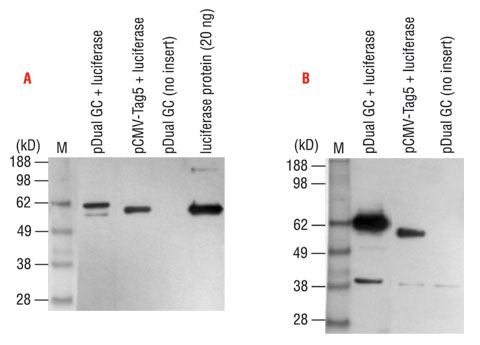pDual Expression System
原核及真核細胞雙系統表現載體
The pDual Expression Vector offers high-level expression of heterologous genes in both mammalian and prokaryotic systems. A special feature of the pDual vector is the tandemly arranged bacterial Shine-Dalgarno and mammalian Kozak consensus sequence. Each ribosome binding site is positioned at its optimal distance from the initiation codon of the target gene for the highest translational efficiency in either mammalian or bacterial cells. The vector also features a calmodulin-binding peptide (CBP) tag which can be used for affinity purification and identification by Western blot.
The pDual GC Vector offers a C-terminal tag with three copies of the human c-Myc epitope tag (one copy is EQKLISEEDL) and a single copy of the 6xHis purification tag. The c-Myc epitope and 6xHis purification tags, expressed on the C-terminus of the protein, can be used for easy detection and purification of the fusion protein from mammalian and bacterial cell lysates. Use of the c-Myc epitope and the 6xHis purification tags allows every target gene to be detected and purified using the exact same protocol and reagents, saving you time and money.
特色
The pDual expression vector directs expression of heterologous genes in both mammalian and prokaryotic systems. For constitutive expression in mammalian cells, the pDual expression vector contains a mutagenized version of the promoter/enhancer of the human cytomegalovirus (CMV) immediate early gene. Inducible gene expression in prokaryotes is directed from the hybrid T7/lacO promoter; the pDual expression vector carries a copy of the lac repressor gene (lacIq), which mediates tight repression in the absence of isopropyl- ß -D-thio-galactopyranoside (IPTG). Efficient translation of mRNA generated in either the mammalian or prokaryotic system is achieved by a tandemly arranged Shine-Dalgarno/Kozak consensus sequence. In both bacterial and mammalian cells, the dominant selectable marker is the neomycin phosphotransferase gene which is under the control of the ß-lactamase promoter in bacterial cells and the SV40 promoter in mammalian cells (Figure 1). Expression of the neomycin phosphotransferase gene in mammaian cells allows stable clone selection with G418, whereas in bacteria the gene confers resistance to kanamycin selection.
 Figure 1. Western Blot Analysis of Transfected Mammalian Lysates From CHO cell lysates, 1 mg of protein was electrophoresed on a 4-20% tris-glycine-SDS gel, then transferred to a nitrocellulose membrane, and reacted with antiluciferase (A) or anti-c-myc (B) antibodies. Antibody binding was detected using chemiluminescence methods. The difference in molecular weights of the different detected proteins is due to the use of epitope and purification tags. Estimated molecular weights: pDual GC + Luciferase is 68 kDa, pCMV-Tag5 + Luciferase is 63 kDa, and luciferase protein is 61 kDa. The difference in chemiluminescent signal between pDual GC + Luciferase and pCMV-Tag5 + Luciferase (B) is probably due to the presence of three copies of the c-myc epitope in the pDUAL GC vector and only one copy of the c-myc epitope in the pCMV-Tag5 vector. The lower molecular weight band that is detected at about 40 kDa with the anti-c-myc antibody (B) was also detected in control cells that had not
Figure 1. Western Blot Analysis of Transfected Mammalian Lysates From CHO cell lysates, 1 mg of protein was electrophoresed on a 4-20% tris-glycine-SDS gel, then transferred to a nitrocellulose membrane, and reacted with antiluciferase (A) or anti-c-myc (B) antibodies. Antibody binding was detected using chemiluminescence methods. The difference in molecular weights of the different detected proteins is due to the use of epitope and purification tags. Estimated molecular weights: pDual GC + Luciferase is 68 kDa, pCMV-Tag5 + Luciferase is 63 kDa, and luciferase protein is 61 kDa. The difference in chemiluminescent signal between pDual GC + Luciferase and pCMV-Tag5 + Luciferase (B) is probably due to the presence of three copies of the c-myc epitope in the pDUAL GC vector and only one copy of the c-myc epitope in the pCMV-Tag5 vector. The lower molecular weight band that is detected at about 40 kDa with the anti-c-myc antibody (B) was also detected in control cells that had notThe unique cloning region of the pDual expression vector is characterized by the presence of two Eam1104 I recognition sequences (CTCTTC) directed in opposite orientations and separated by a spacer region encoding two EcoR I sites. Digesting the vector with the Eam1104 I restriction enzyme creates a 3-nucleotide 5´ overhang that is complementary to the translation initiation codon (ATG) of the DNA insert.
Inserts must be generated by PCR amplification with primers that contain Eam1104 I recognition sites and a minimal flanking sequence at their 5´ termini. The ability of Eam1104 I to cleave several bases downstream of its recognition site allows the removal of superfluous, terminal sequences from the amplified DNA insert. The elimination of extraneous nucleotides and the generation of unique, nonpalindromic sticky ends permit the formation of directional seamless junctions during the subsequent ligation to the pDual expression vector.
The pDual vector contains the Calmodulin Binding Peptide (CBP) affinity tag, located 3´ to the cloning site, for optional fusion of the affinity tag to the carboxy terminus of the protein-coding sequence of interest. The CBP-affinity tag is preceded by a thrombin cleavage site which allows the removal of the fusion tag from the protein of interest.
產品列表
| 貨號 | 產品 | 數量 | |
|---|---|---|---|
| 214503 | pDual GC Expression Vector pDual GC 表現載體(組) 廠牌:Agilent | 20 µg | |
| 214501 | pDual Expression Vector pDual 表現載體(組) 廠牌:Agilent | 20 µg | |
| 214502 | pDual Expression Vector pDual 表現載體(組) 廠牌:Agilent | 100 µg |
pDual Expression System
- Eliminates the need to subclone
- Express protein as a native or tagged fusion protein
- Bacterial expression is T7-based
回到頂端


